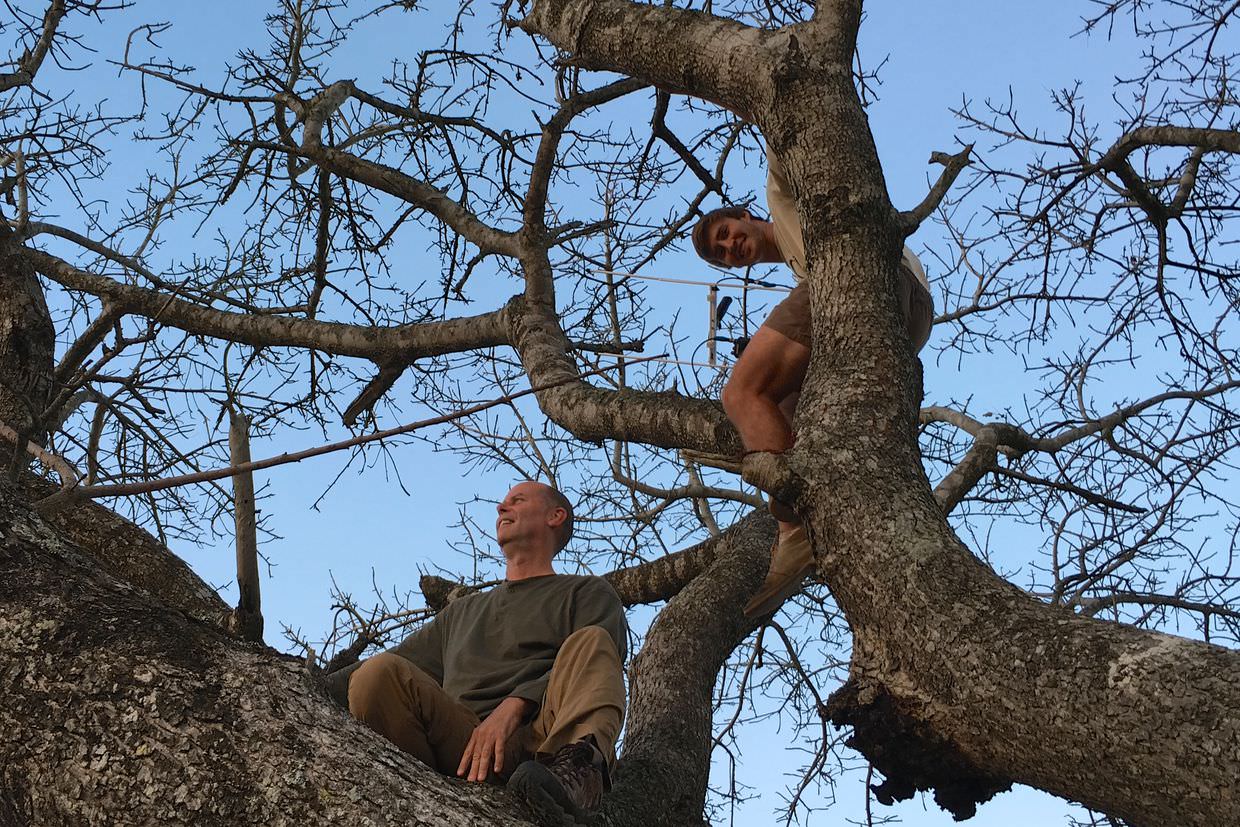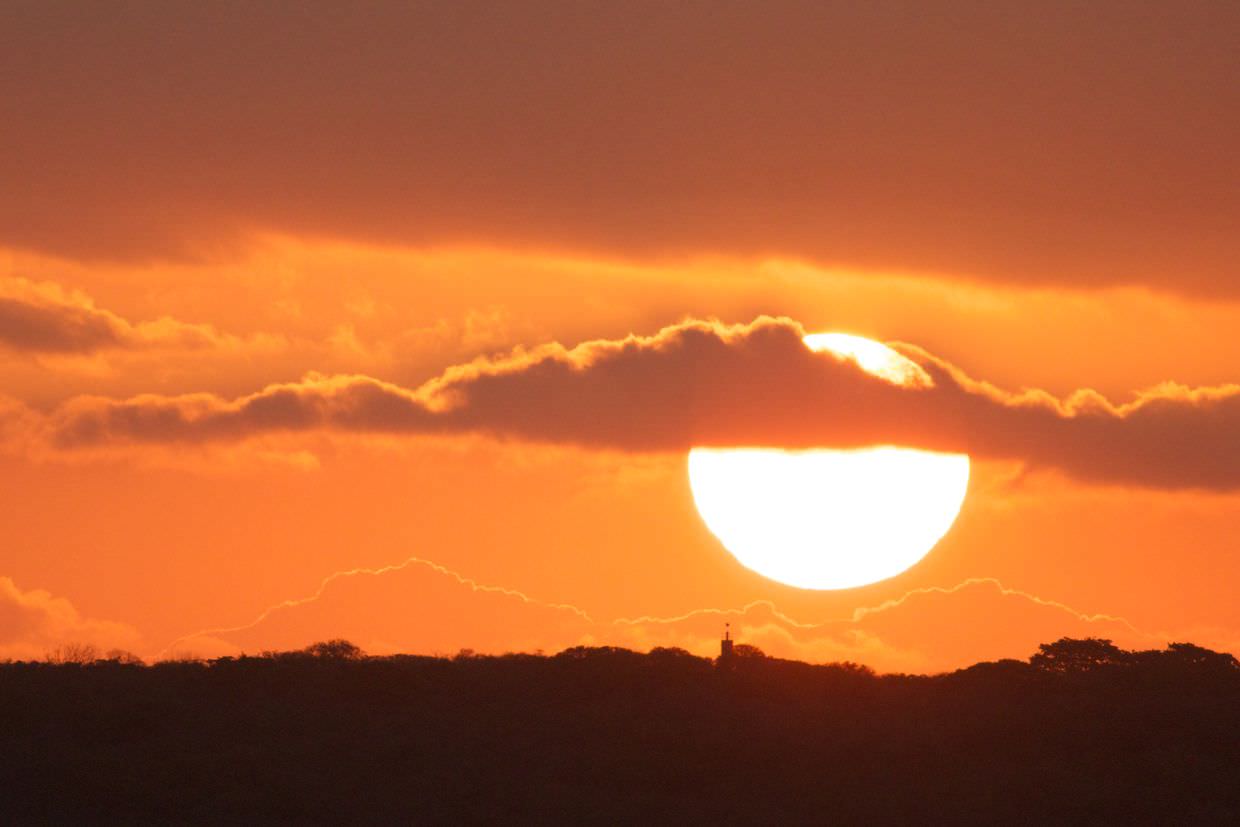Finding lions, tempting Elsa
Day 5 - Driving north
My favourite excursion during the my 2 weeks in Tembe was this trip up north. We needed to change some camera traps, scan for lions, and pick up some gear from the northernmost outpost. That meant a 4am start, thankfully the weather was fair, some stars sparkled as we left and the moon shone brightly. It’d be a long drive, once we’d checked the boma.
The entirety of the north is closed to visitors, no tourists can drive the route we were taking. The roads are few; a single circuit goes up the West side, and comes down the East; the animals have at least some wilderness without humans. This part of the reserve looks different; there’s rolling hills covered in grass, broken by the occasional copse. Giraffe gather amongst the small groups of trees, and in the morning sunshine the view looks magical.
It was in this open grassland that we came across two uncollared lions; two sub-adults, siblings, they’d recently left their mother and were hunting on their own. They hadn’t been seen for months. The female sat on the road, legs out, perched like a dog. Her brother was harder to see, lying down in the long grass, his yellow fur making the perfect camouflage. His mane looked like a stylish teenage haircut. They noticed us, but soon turned their gaze to the herd of giraffe. Were they really stalking giraffe?
The lioness joined her brother in the grass, lying down, they watched the giraffe intently. Hayden drove us closer, giving us a fabulous view of the two. The giraffe noticed them, the group of six stared, always keeping an eye on their would-be hunters. We could have stayed with them all day, were it not for all the things we needed to do and the long drive ahead of us. We left them, as they wandered off in the direction of the herbivores.
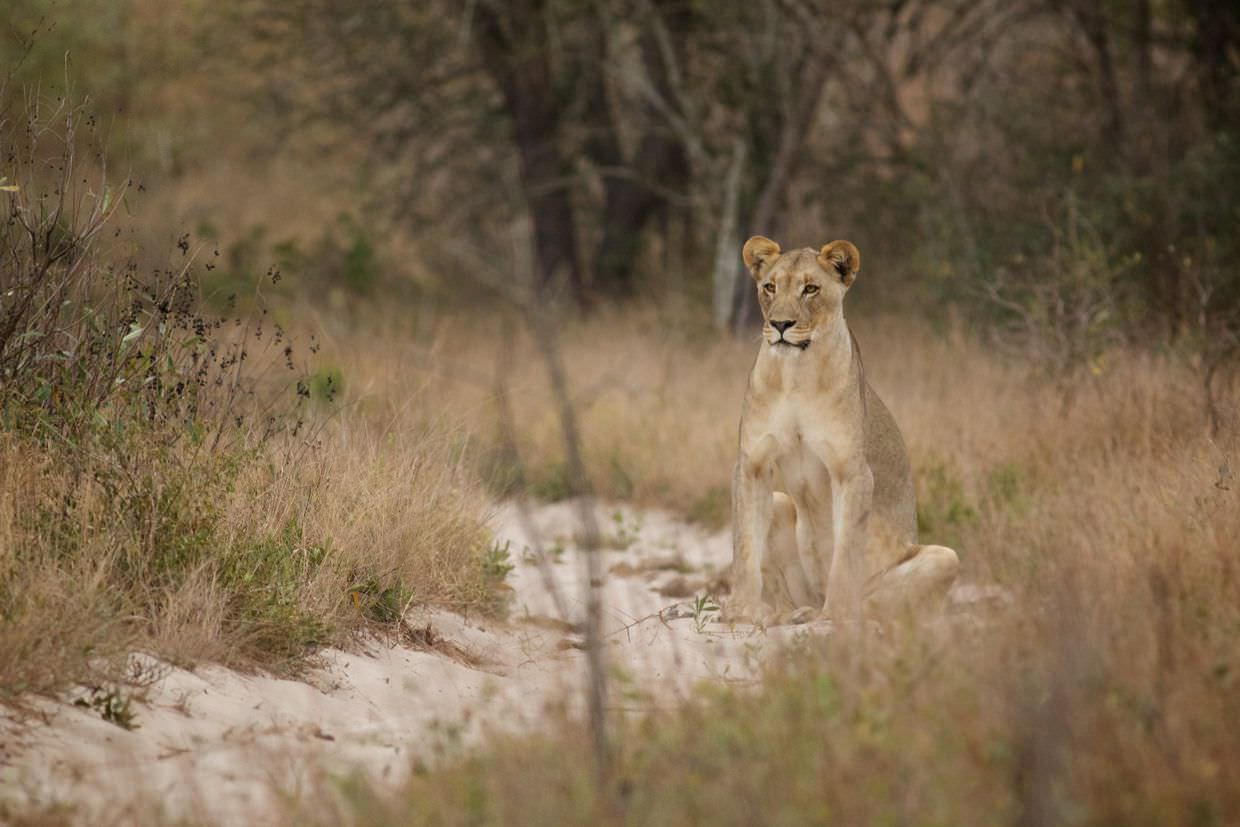
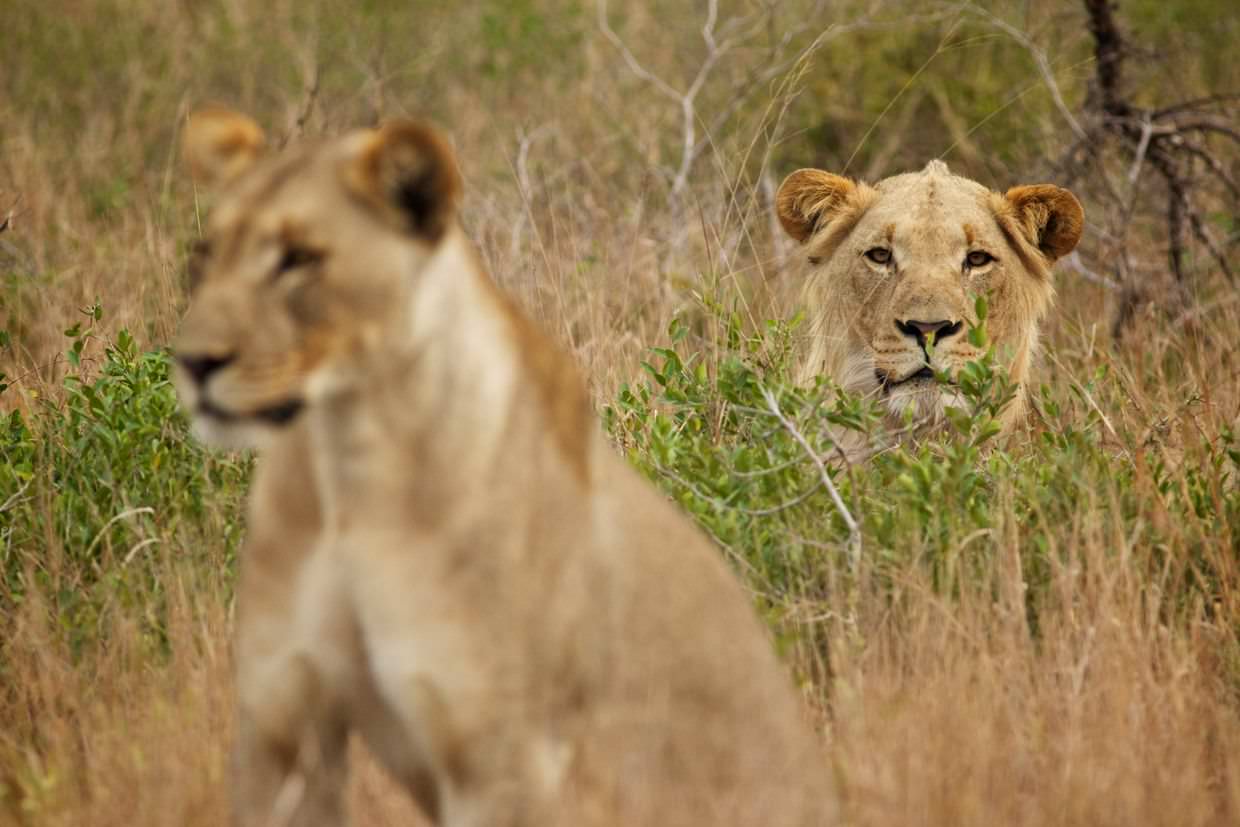

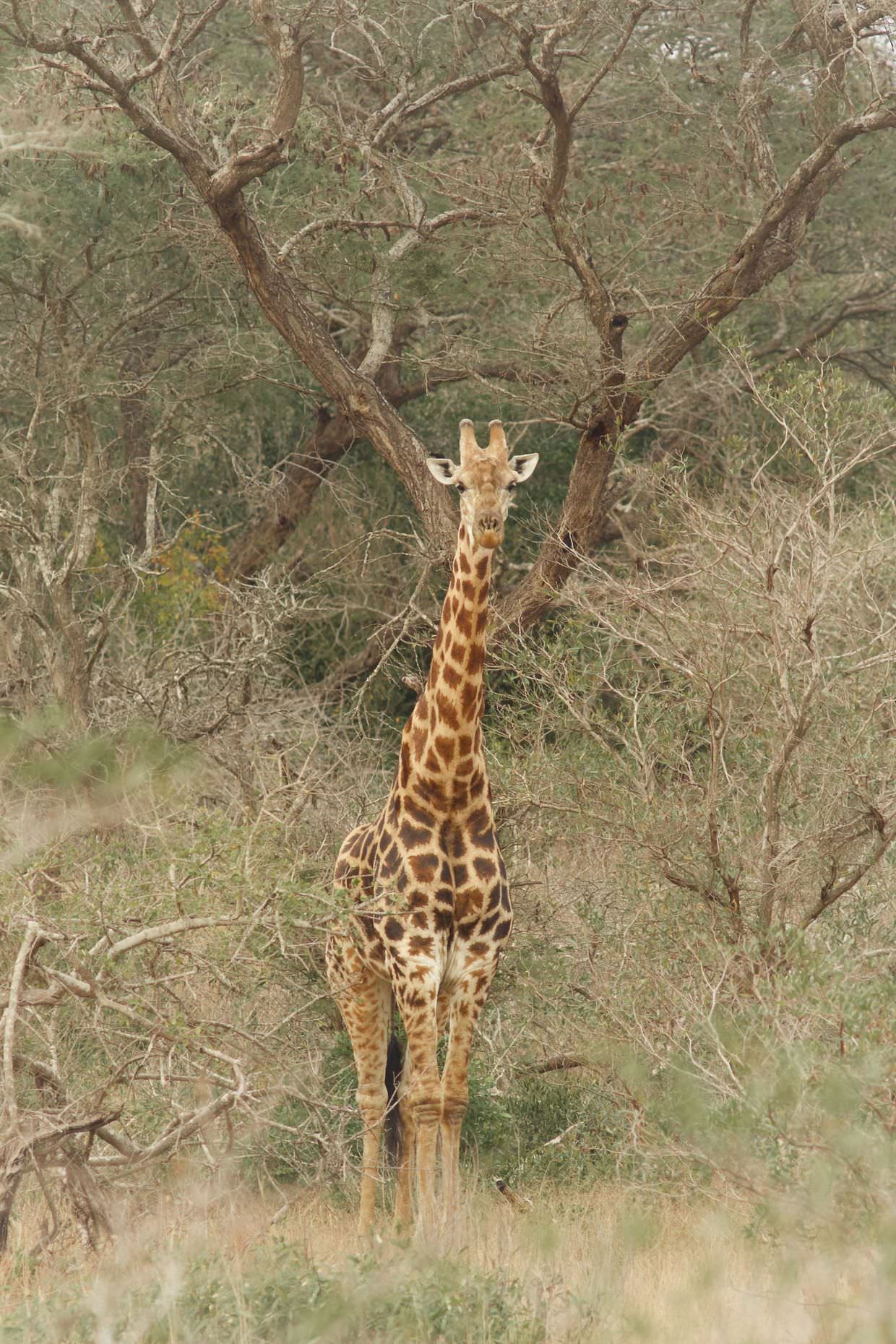
We continued driving through the grasslands, past herds of wildebeest and the occasional grey duiker. I saw too the only reedbuck on my entire trip, a young’un and a goofy looking female with a white patch on her head. Zebra looked picturesque strolling amongst the long grass and leafless trees.
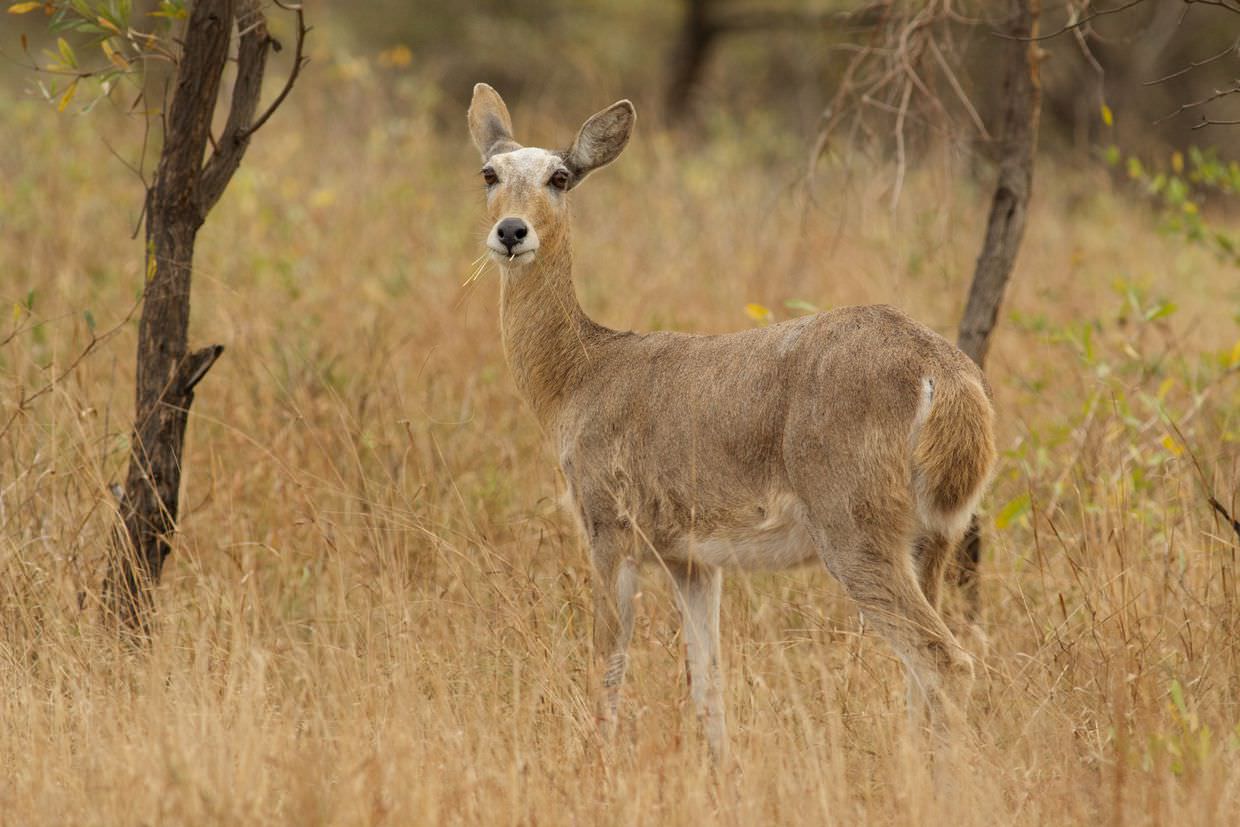
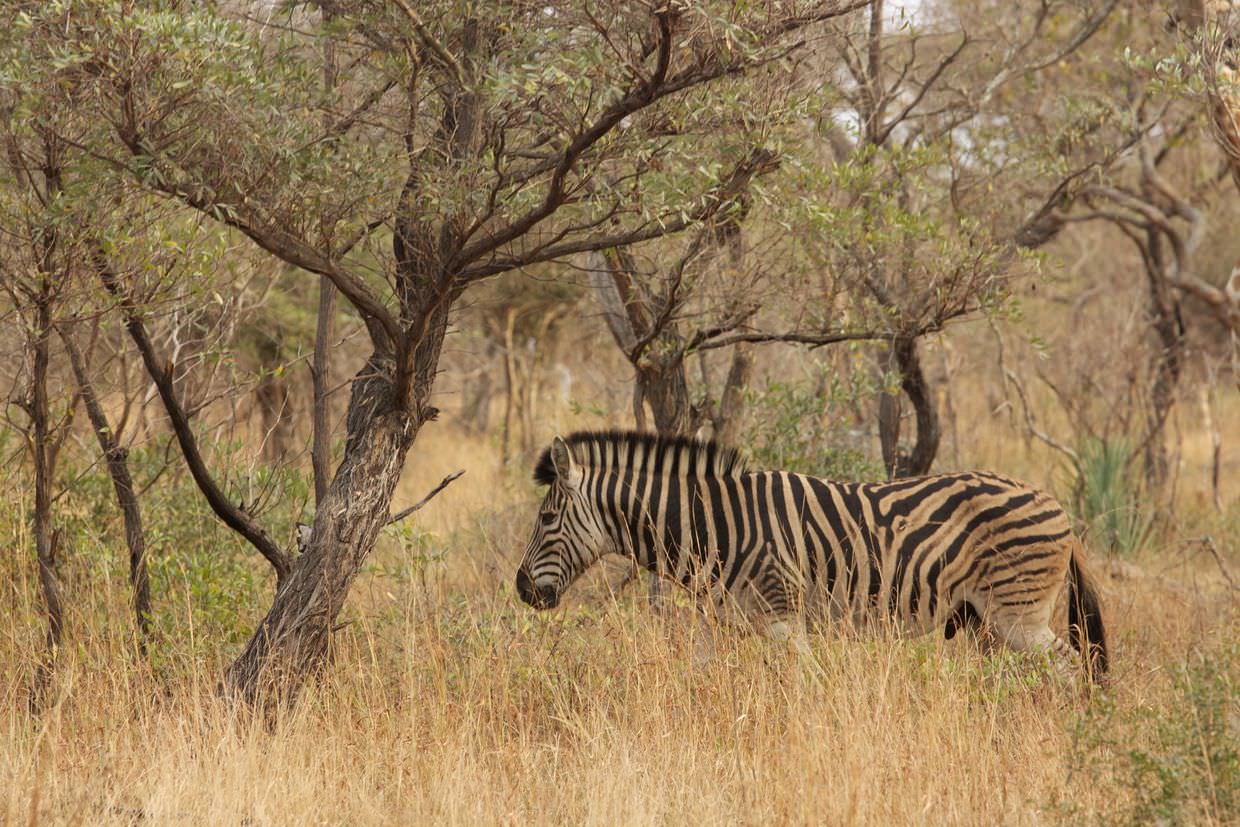
It was while driving, while I was scanning for lions, that Hayden swerved and stopped suddenly. He moved to avoid crushing a dung beetle and its great big ball of elephant dung. This flattened giant dung beetle was using its hind legs to roll dung along the road, while its mate waited patiently on the ball, spinning upside down as the sphere rolled. We’d seen dung beetle flying; they’re enormous and you wouldn’t want one to hit you while driving, it’d give you a black eye – Hayden knows this from experience. It was nice to see one up close, doing that thing their famous for.
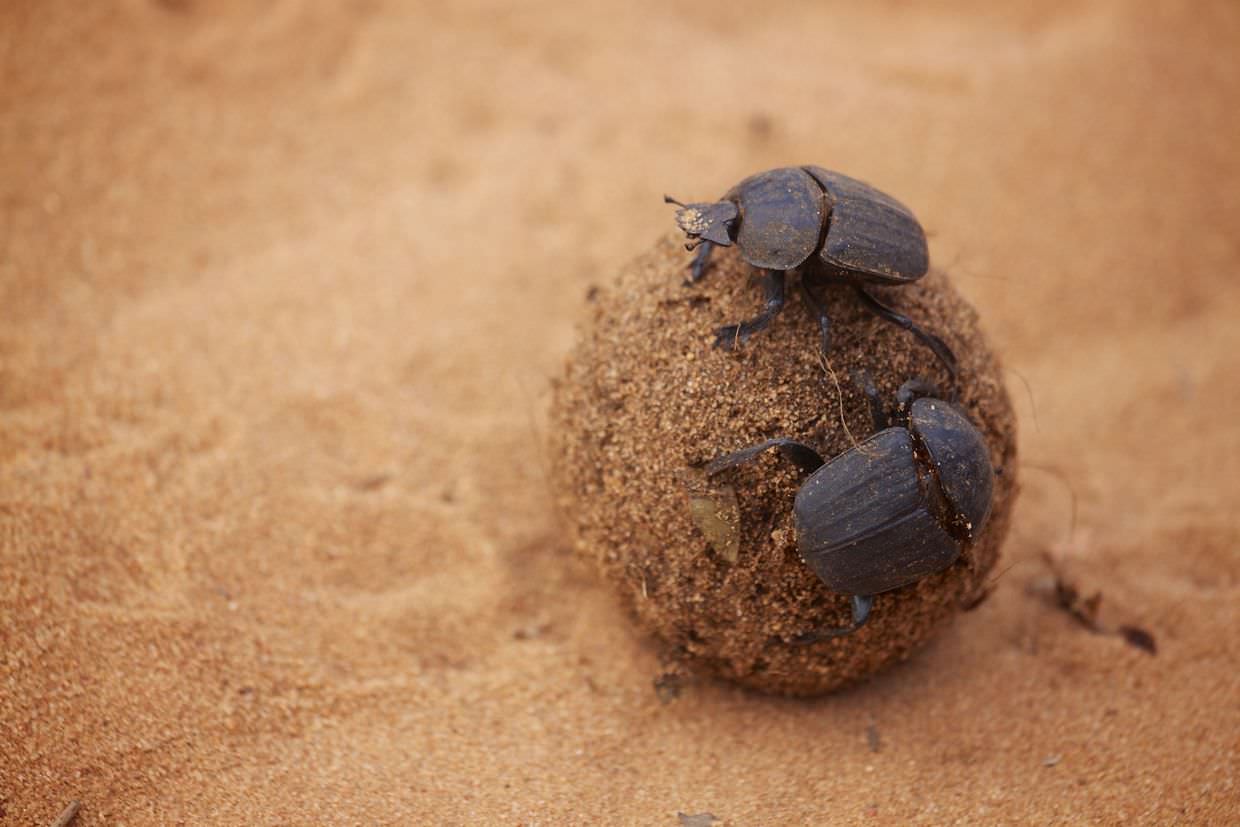
At the Muzi borderpost we grabbed what we needed and sorted the camera traps, then it was time for coffee near the fence line. This edge of the park also happens to be a national border; we were looking into Mozambique, while sipping instant coffee. Two anti-poaching soldiers sat nearby, resting on a rock, rifles besides them. A little bee-eater perched on the barbed fence, and vervet monkeys ignored the national boundaries.
On the drive back we stopped to pick some monkey orange; a hard skinned pulpy fruit; the animals love it, particularly the elephants. Nyala, impala and duiker were all loitering very close. We passed flocks of crowned hornbills; flying like a roller-coaster, up and down, up and down, their eyes are piercing – like they’re always annoyed at you.
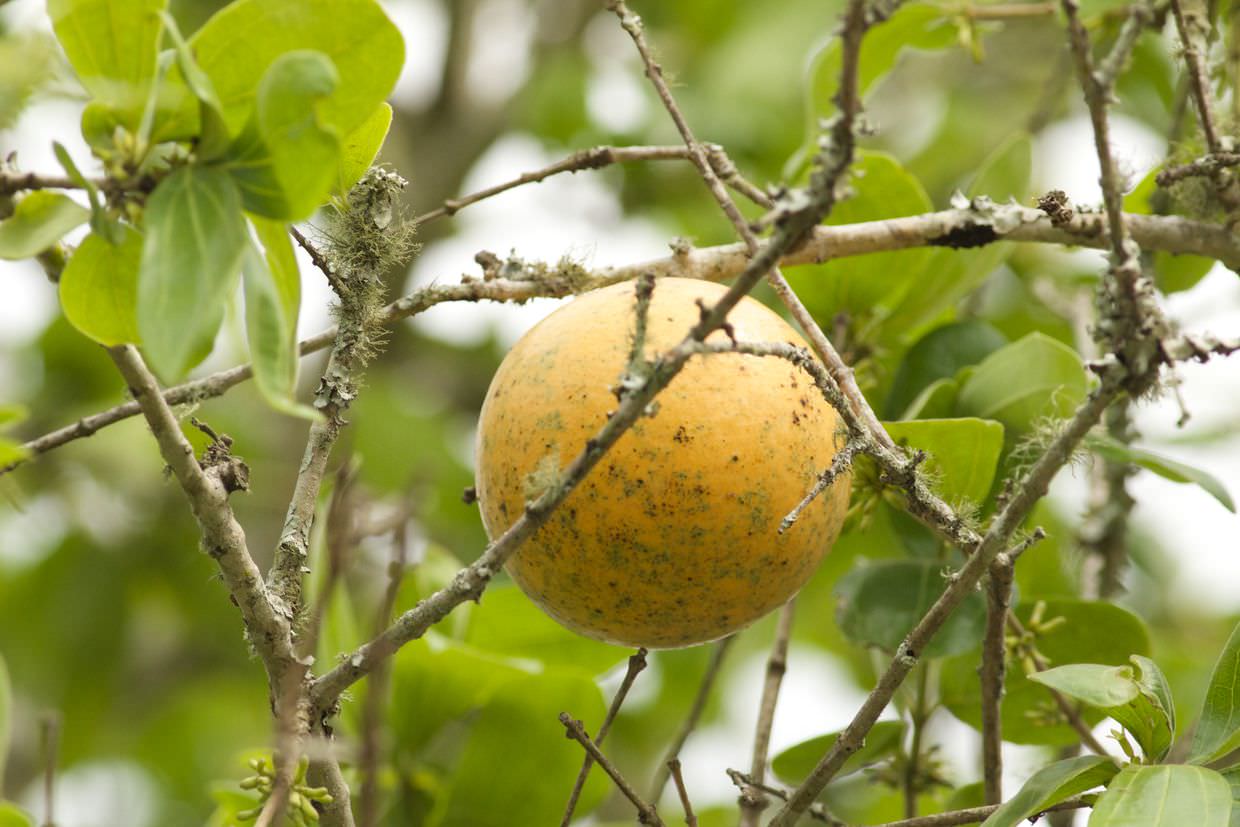
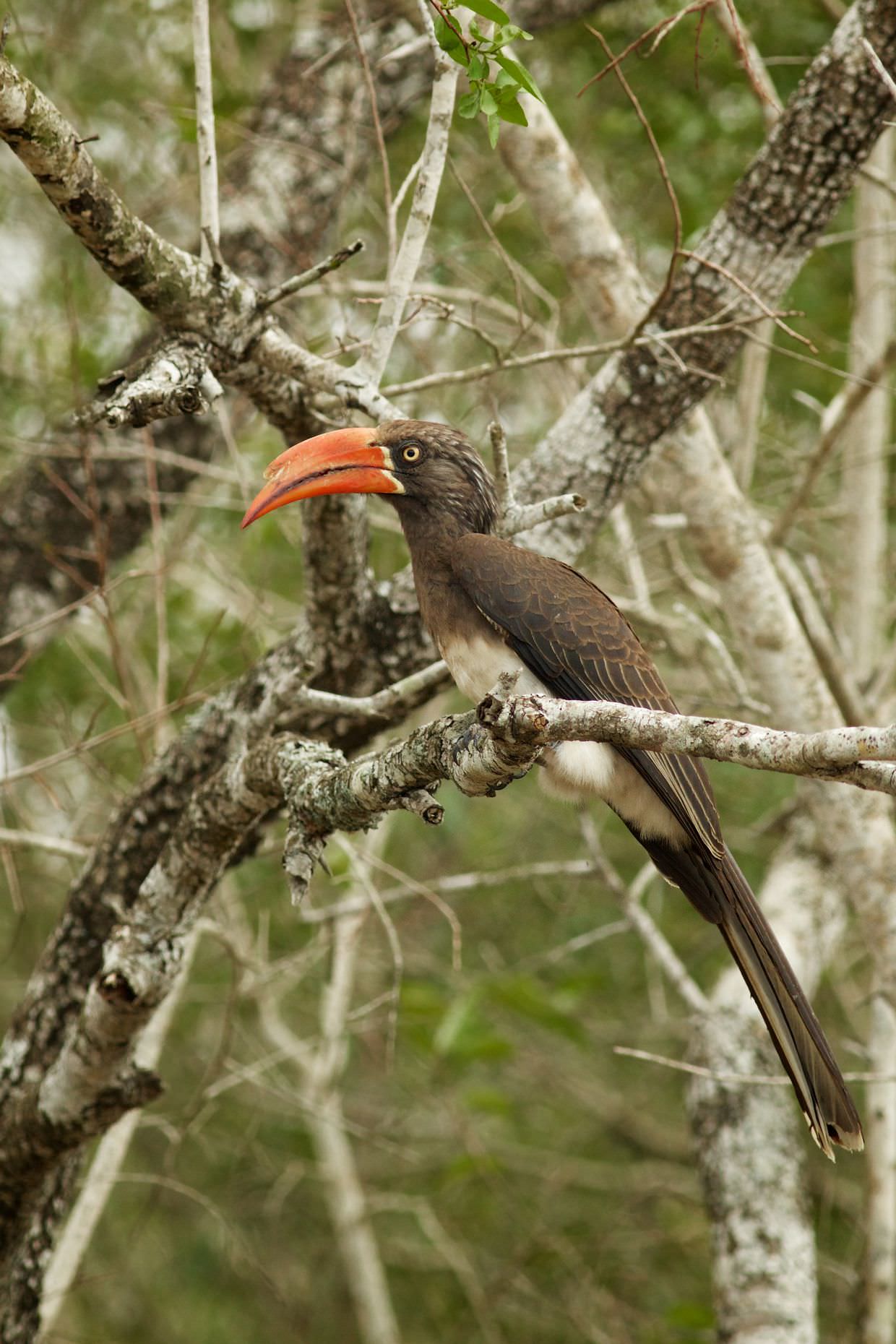
After the 7 hour drive we enjoy the last remnants of the sunshine by the kitchen; some nyala drink from our water bath, we feed the tame bulbuls by hand and we shoo away the vervets. Forecast says storms.
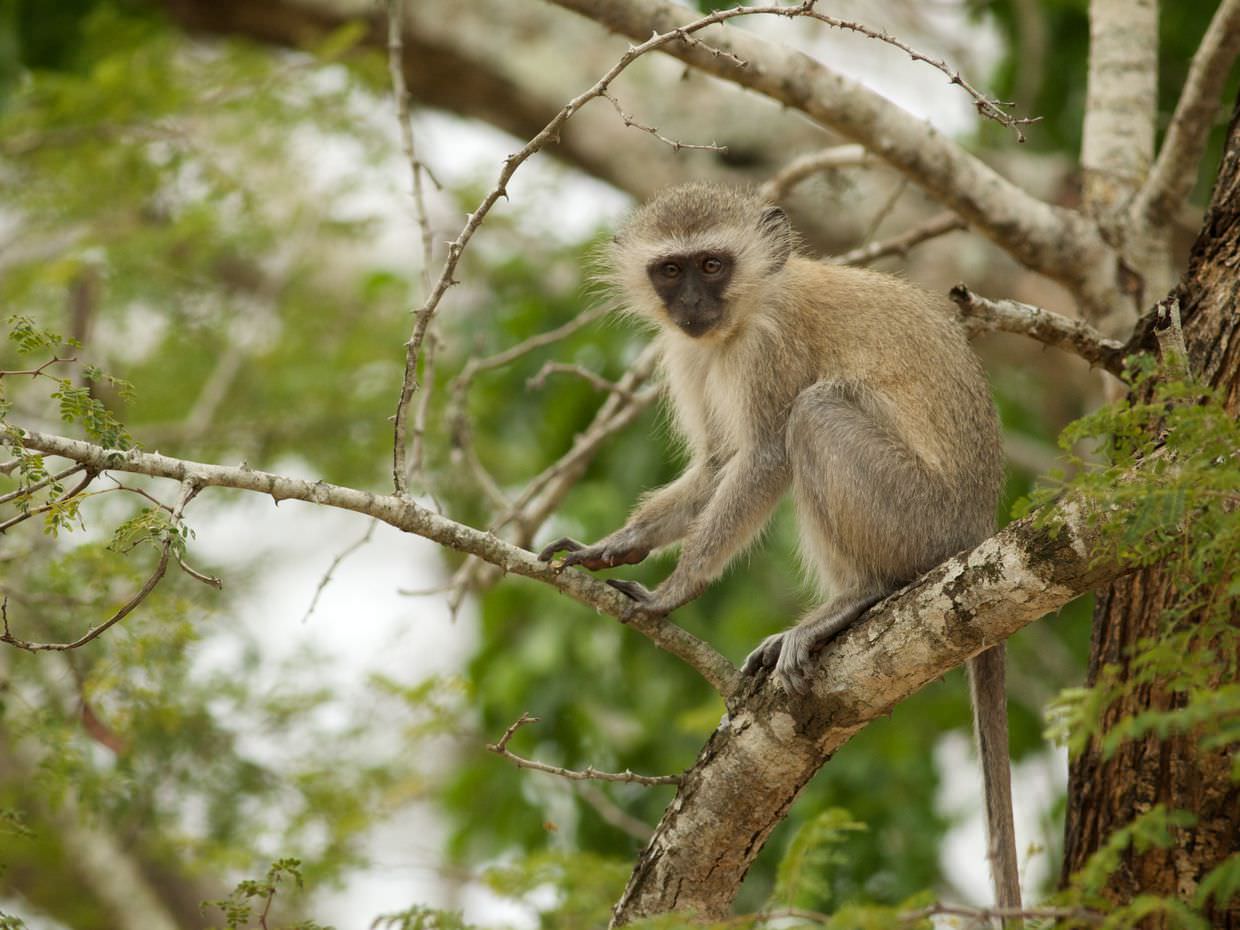
The evening session was another trip to the boma; we scanned for Elsa, she was about, still hanging around, sticking with her pack. We had some bait with us to lure her out, but the skies were heavy, thick with cloud, and thunder rumbled in the distance. We stopped early when a bolt of lightning struck nearby – it’s not a good idea to stand on a truck holding a big metal aerial in a thunderstorm.
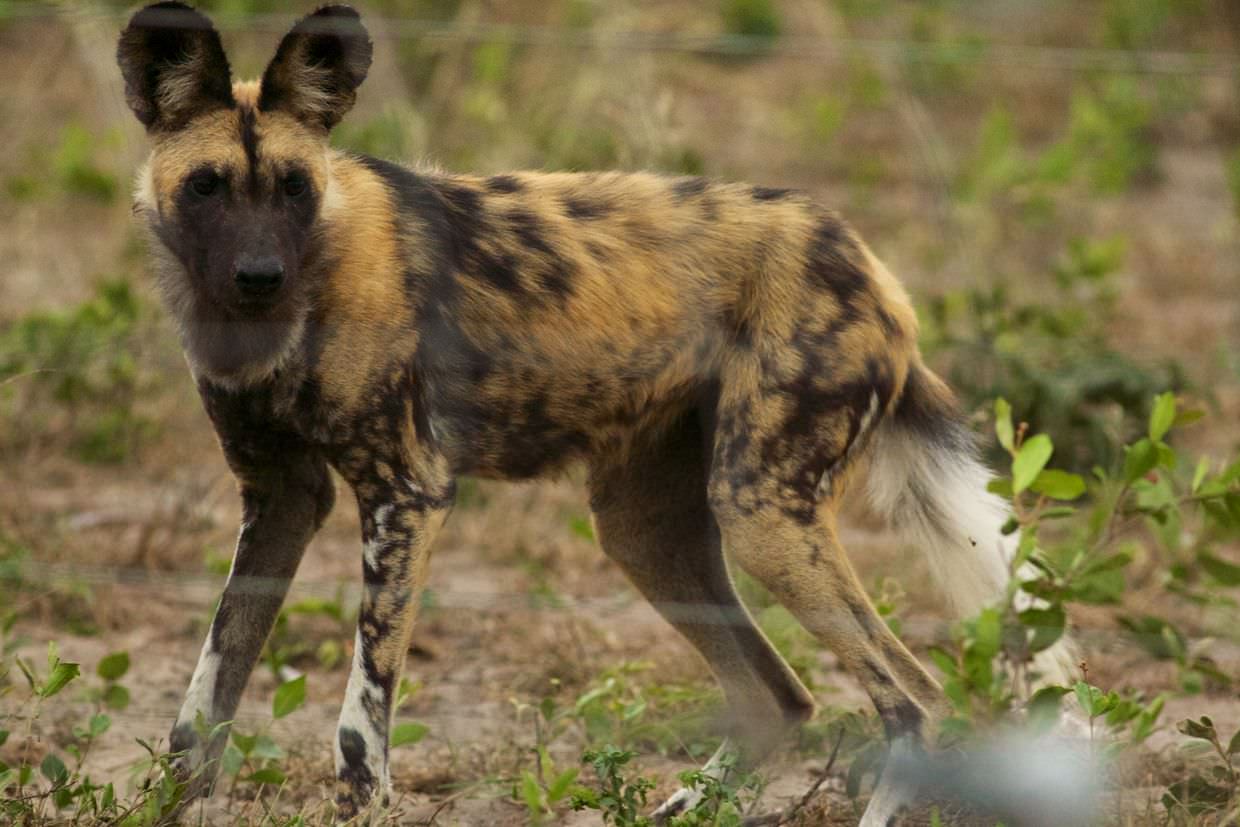
Day 6 - When it rains, it pours
It rained overnight, but at 4:30am it seemed dry. We set off toward the boma in our wet weathers, rucksacks in black bags; it’ll be fine if it rains, we tell ourselves. As we near the boma the rain starts, a light drizzle, but its cold, the wind is chilly, it’s an uncomfortable start and we sit on our hands to keep warm and dry.
At the boma the electrics are down; something had shorted them overnight and drained the battery. Elsa’s been busy too, there’s another fresh carcass by the fence – she’s nearby, guarding her kill. We didn’t bring a bait with us, but this will do nicely. Hayden cuts off a leg, and we drive slowly around the fence, trying to get close to Elsa – the aim, to get eye contact then to drop the bait off the back, so she knows the food came from a truck – a mini habitualisation. Ideally we could use it to tempt her into the other half of the boma, currently vacant. We see her, we drop the leg and we drive away; it works, but Elsa and the puppy soon disappear into the thicket to eat it. It’s a start at least. The pup looks well. We give the rest of the carcass to the pack inside the boma.
Just as we’re done, and as we consider scanning for lions, the heavens open. Heavy rain drops pelt us, and Hayden sets off for camp. It’s freezing cold, and the water gets through everything; through the wet weather, through the coat; through the wet weather trousers and into my boots. The heavy rain forms channels of water as it runs off us, creating little puddles in all the crevices. It batters us, we’re soaked through, and cold to the bone, shivering. As we speed down the sandy roads, we stare downwards, the water too much to look up, water pours from our hoods, creating waterfalls from our noses. The short drive felt like an eternity.
The temperature doesn’t rise much above 15C all day – two days ago it was 30C; camp is cold, and the wet weathers struggle to dry. One cabin has a heater; we fill it with the wets and turn it on – hoping our warm clothes will dry out and we might have boots again tomorrow. We gather around the gas stove, hands out, trying to warm up as we make coffee.
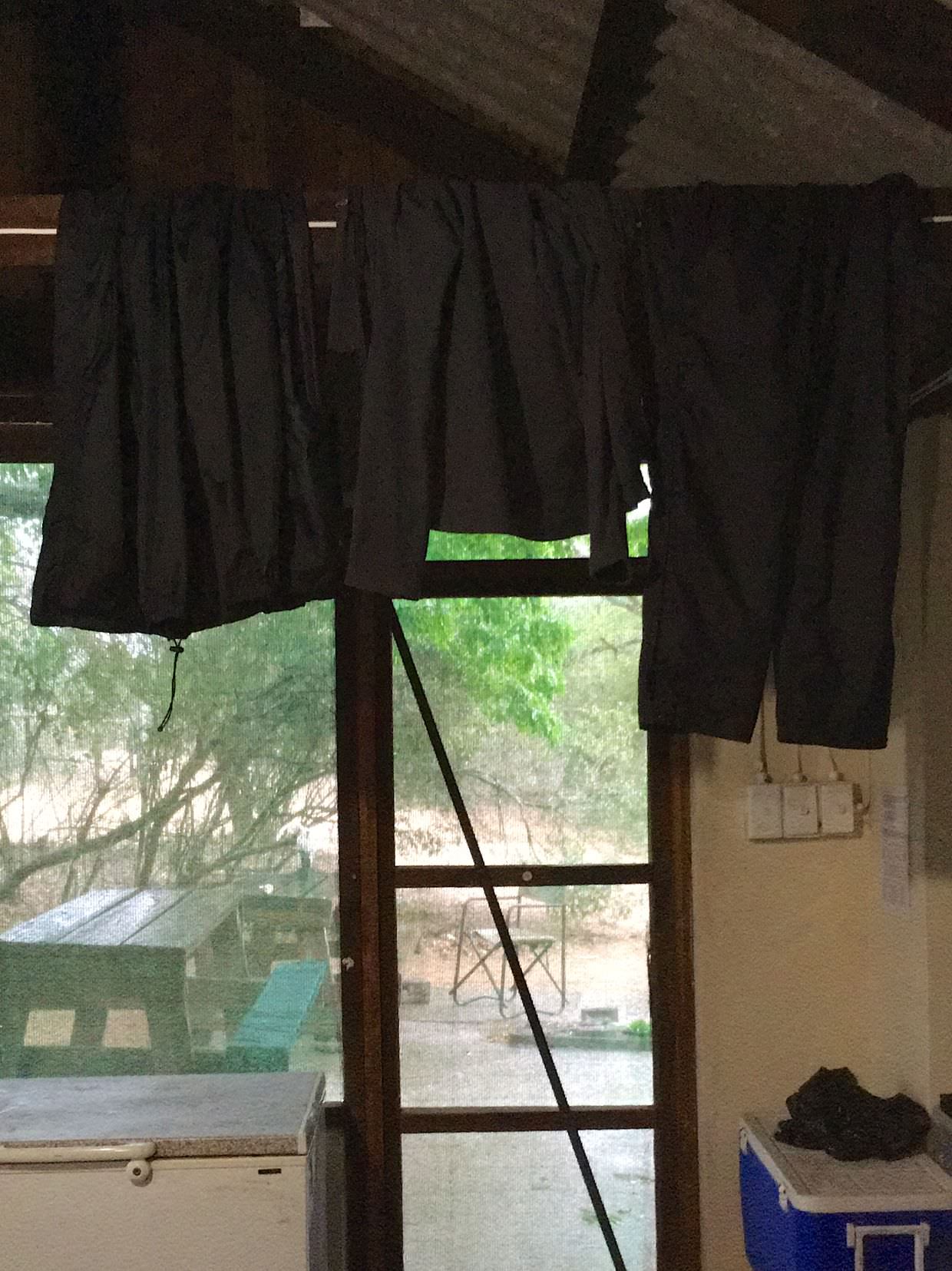
It rained all day, and we never really got comfortable – camp isn’t designed for the cold. We didn’t go out on session again, though Hayden drove to the boma for a quick check before nightfall. The upside; this park really needed the water, about 13mm fell. I had rain again in my 8 weeks, but it was never this cold; I had a downpour that was heavier, but it was warm and almost enjoyable. Thankfully a cold rain shower like this happened just the once, and we weren’t far from camp.
Day 7 - Tempting Elsa
At 5am this morning it was back to the boma. Thankfully our warm clothes had dried, it wasn’t raining, but it wasn’t warm either. At the mortuary we picked up our bait, a frozen leg of nyala, “a meat popsicle”, Hayden called it, plus a fresh leg. At the boma we pick up a strong signal for Elsa and quickly find her.
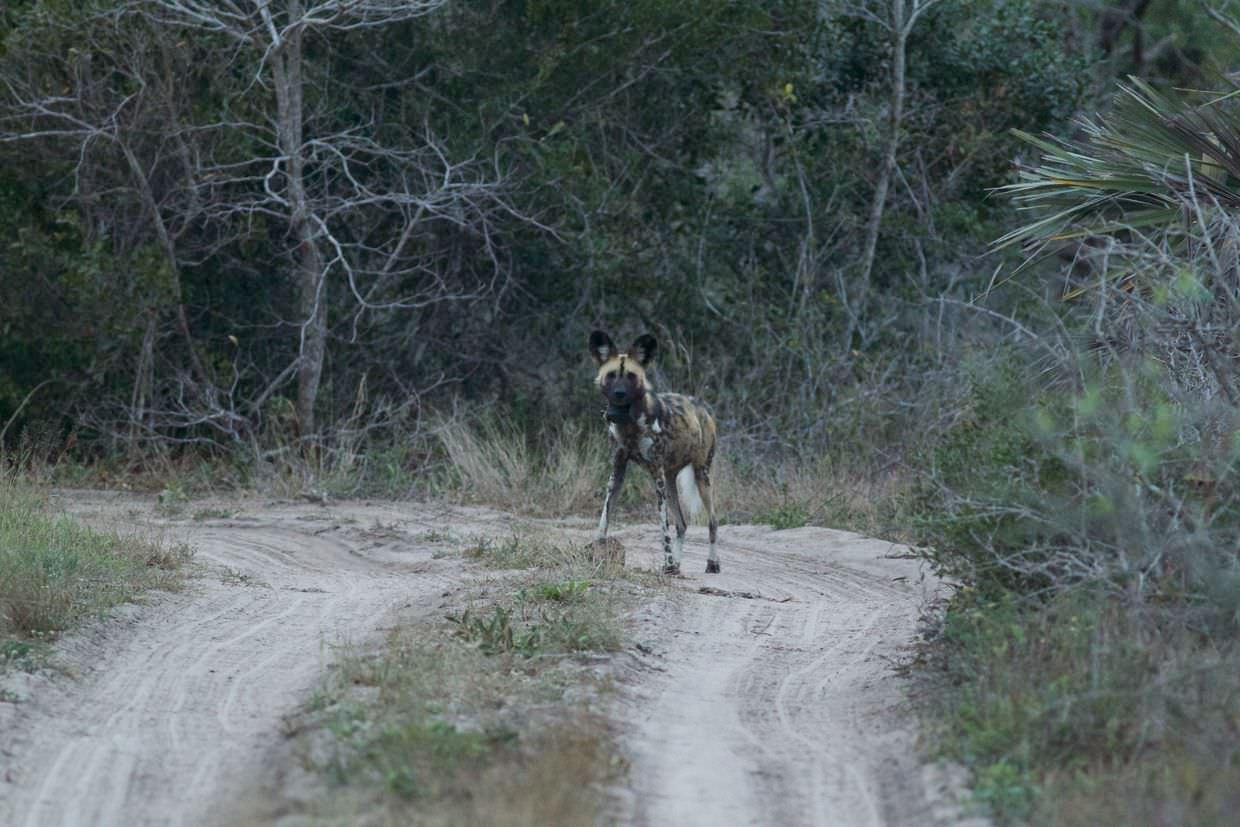
We use one of the legs to tempt her out of the thicket – we drop it and keep driving; it kind of works, she emerges and grabs the whole thing but then disappears into the bush with it; the plan failed.
Plan B: Using the food we had for the rest of the pack, we attempt to tempt Elsa into the vacant half of the boma. We tie the leg to the back of the truck and drag around the sandy tracks, spreading the scent; we open up the gates to the vacant boma and leave the leg just inside. Maybe, just maybe, she’ll come out looking for the food and walk into the boma to get it. Maybe.
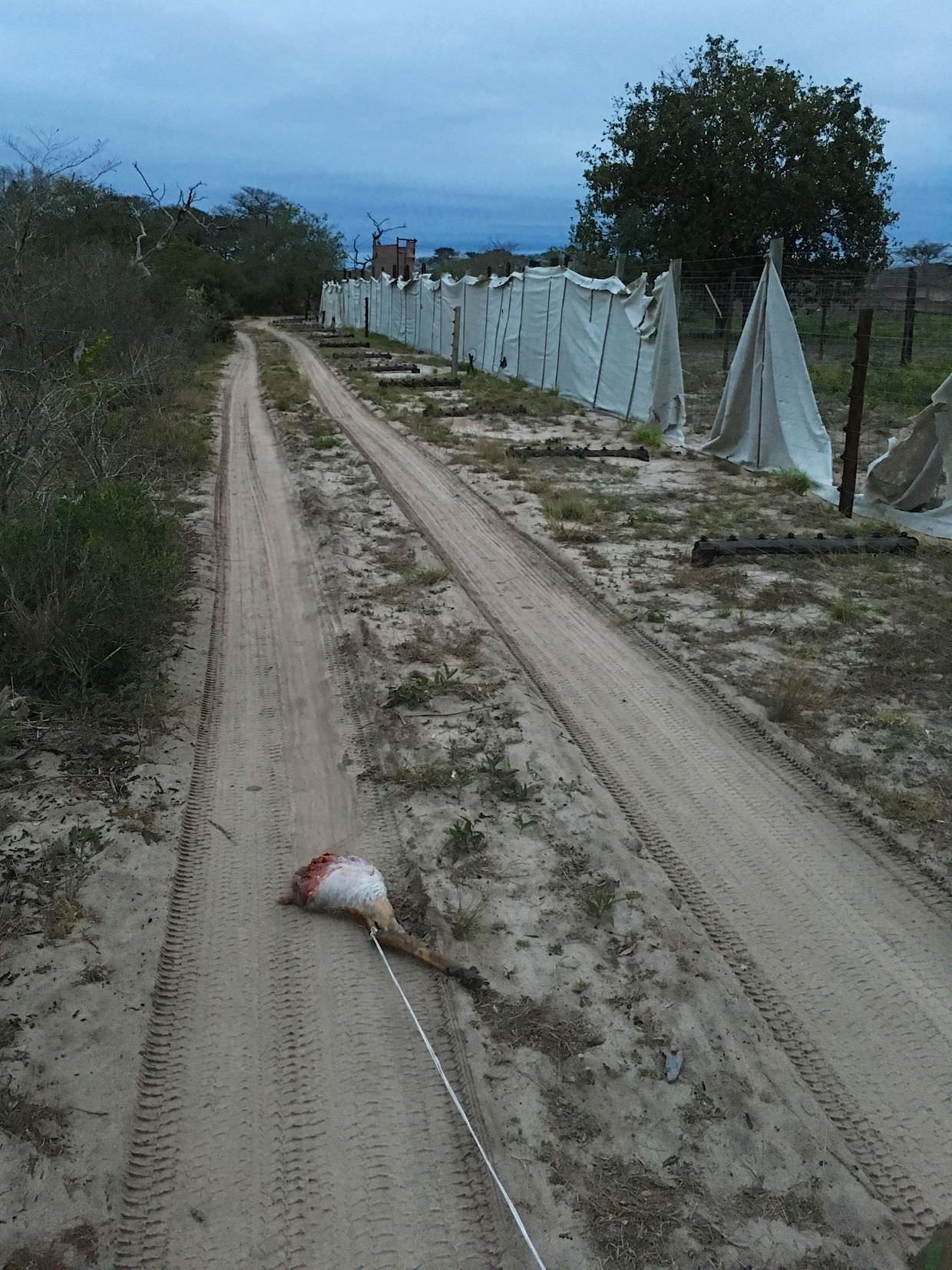
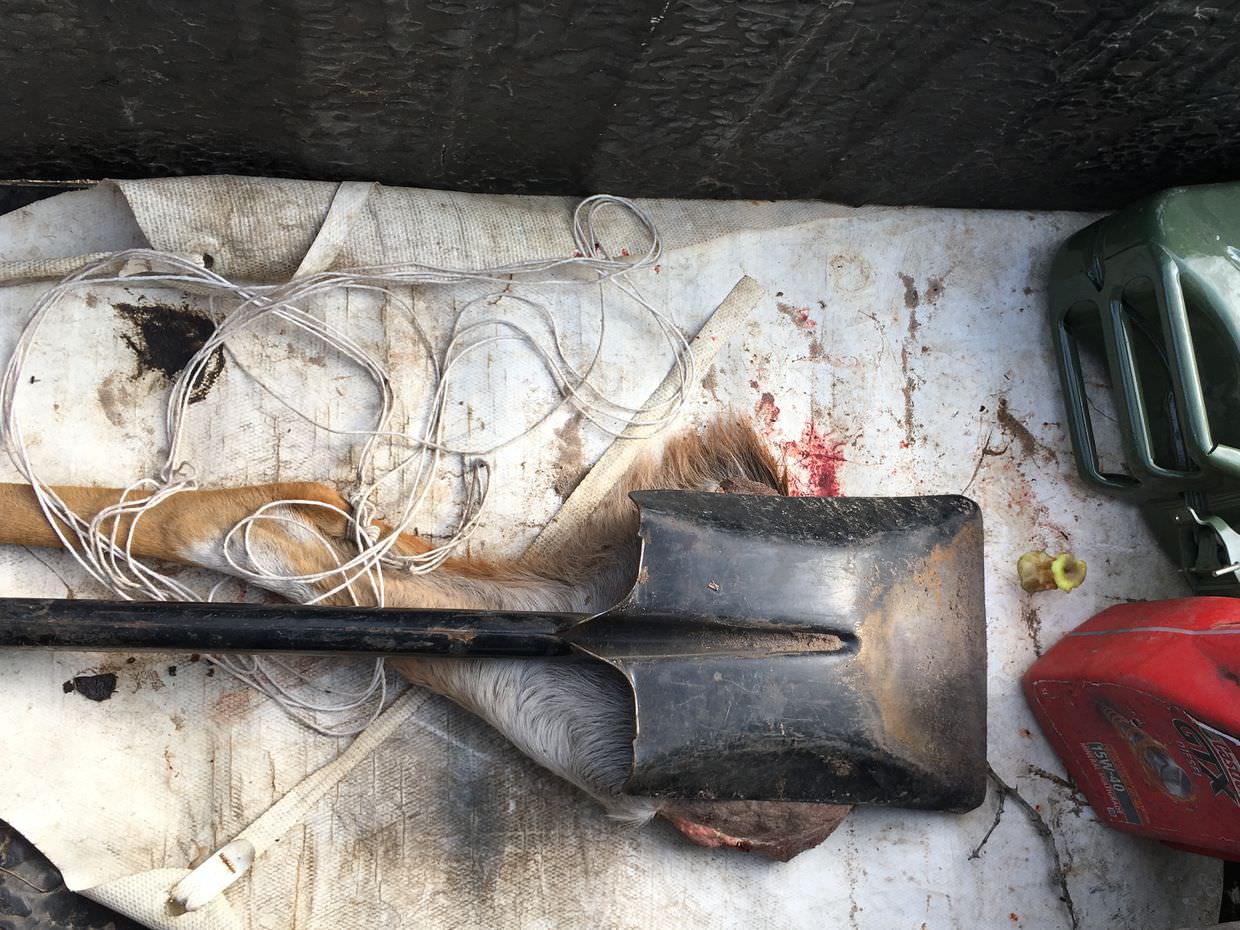

We’re willing her to go in while watching from afar.
We waited for 1h30, to see what would happen. She paces up and down the edge of the boma, interacting with the pack. Her snout sniffs the air, she knows there’s a bait, she inspects the open entrance, stands at the doorway, meat in sight, sniffing the air. “Go in, go in!”, we whisper under our breath, all of us urging her to cross the boundary. She doesn’t, she’s too smart, whether she knows its a trap or she’s afraid of the electrics, she doesn’t go in, and we have to give up. We give the leg to the pack, saving it from the circling kites.
Back to lion monitoring; we scan for M90, Kampa and Nyanga, and we check on the old lion call-up bait. It stinks, the carcass is covered in maggots, but something has eaten most of it. The camera trap later reveals some lions snacking, and then 1,000 images of woolly necked storks.
With the rotten stench of death still fresh in our memories, we drove around to the edge of the hide’s waterhole to have coffee and rusks. A vervet monkey, perched precariously at the top of a leafless tree, eyed us nervously. Around the truck were fresh lion and porcupine tracks, and besides the water elephant and zebra were drinking. A lone wildebeest rolled around in a mud pit, clearly having way too much fun. A bateleur overhead doesn’t come close enough for pictures.
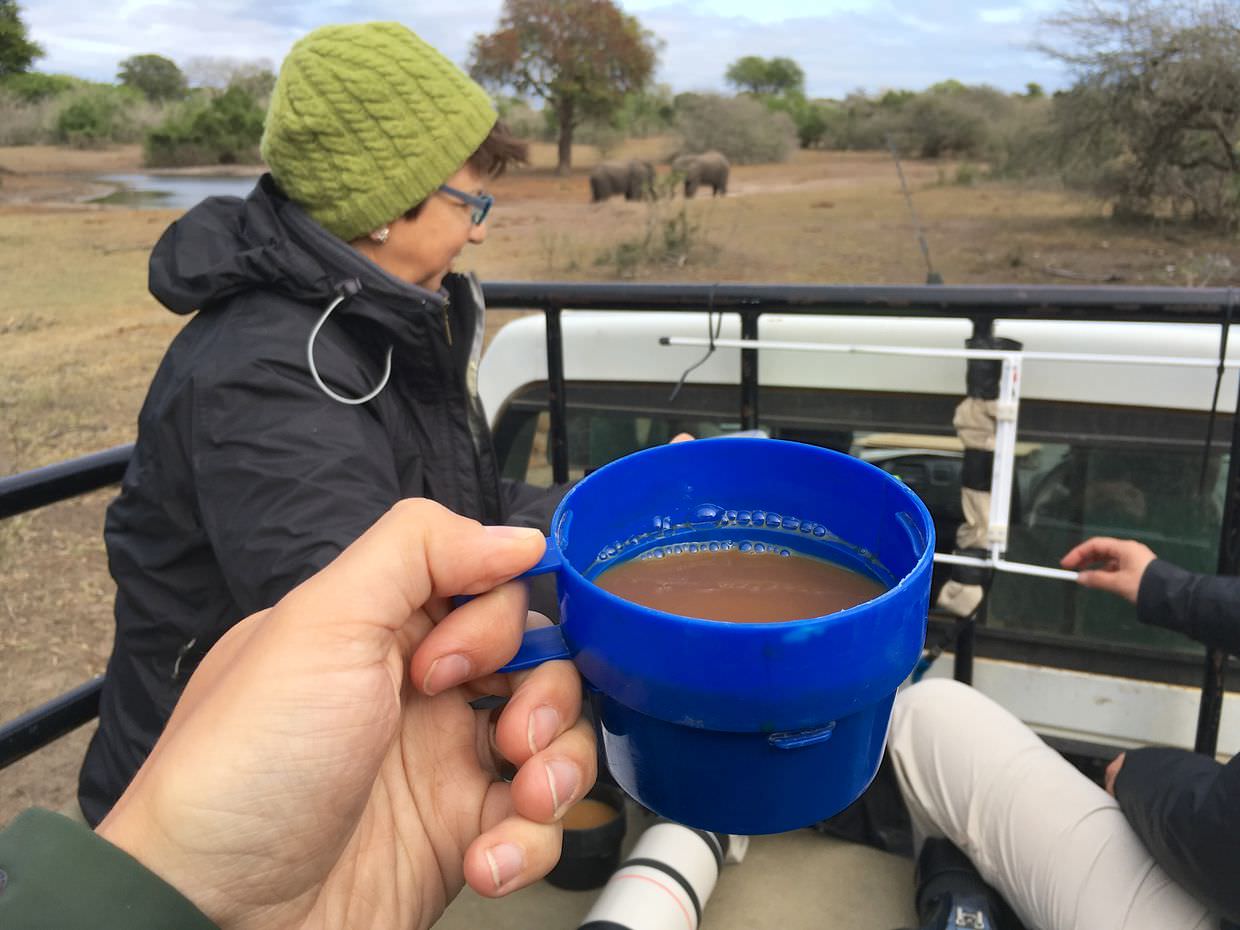
Going west with Leo
Under cloud cover we left at 10:30am for our “ele” session with Leo. Elephants are known to head west after rain, but we found none – bar a breeding herd in the distance, too far to ID, they soon disappeared into the forest. A black-bellied bustard ran about in the long grass.
We stop besides one of the picnic sites for a break. One of the few designated spots tourists can get out – it’s no safer than anywhere else, but there is a re-assuring roped boundary; that’ll keep out the lions for sure. A giant ant queen meandered about in the sand while Leo told us stories about the hardwood newtonias and harder leadwoods, endangered trees – it’s illegal to cut them down, locals still do.
Not far from the picnic site, back on the sandy road looking for elephants, we inadvertently scare a huge crowned eagle. The bird had been feeding on its kill, we’d startled it, and the great bird of prey flew up in front of us and away into the distance. Leo records the sighting and makes a note of the kill; at first we fear its a suni, on closer inspection it’s a baby grey duiker. An impressive catch.
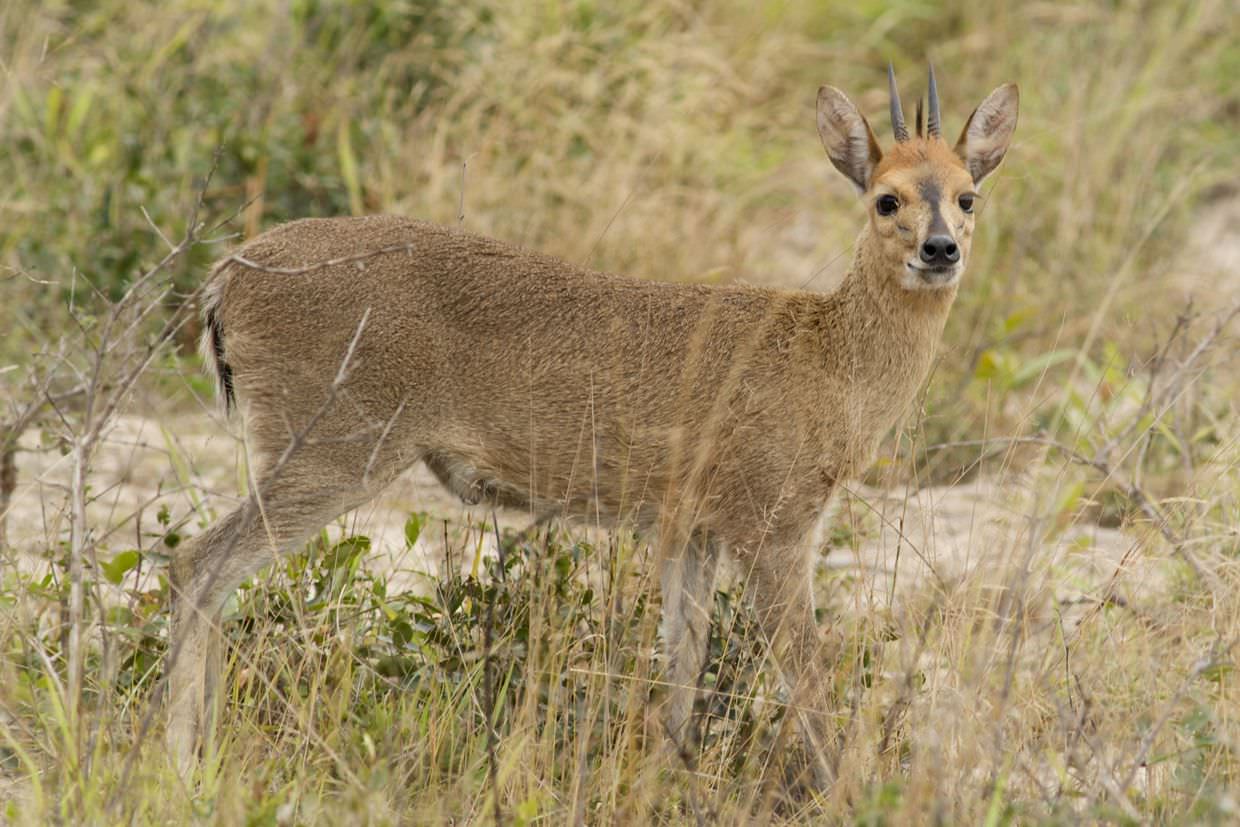
Our final stop is at Mahlasela hide. The waterhole is busy again; male elephants hug the edge; dipping in the water, bathing, drinking, feeding on the boer-bean. A particularly large bull is feeling frisky, and he seems to like another male that’s here too – he gets the wrong idea and gives chase, looking to mate. The small bull flees, doing everything he can to indicate that he too is a male (I’ll leave that to your imagination). They perform this odd dance, as one tries to mount, the other rotates, both escaping and demonstrating.
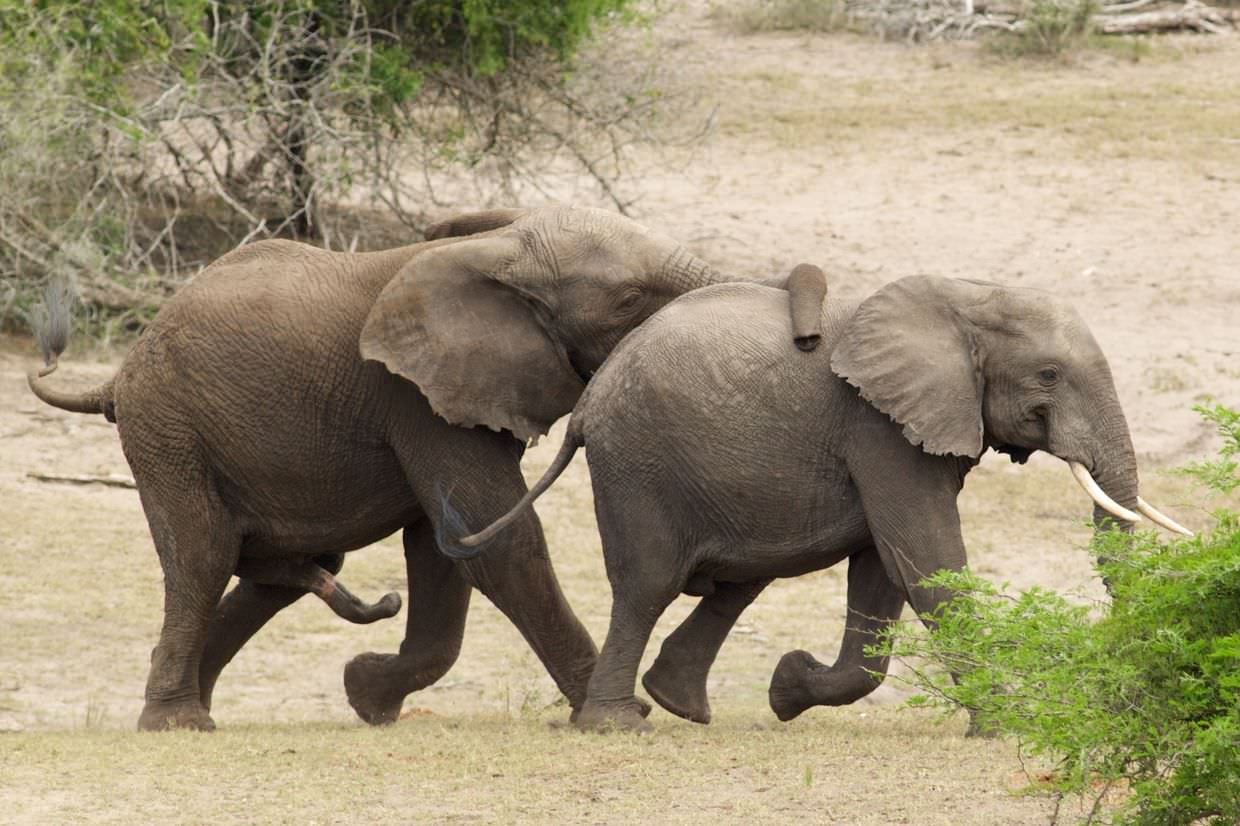
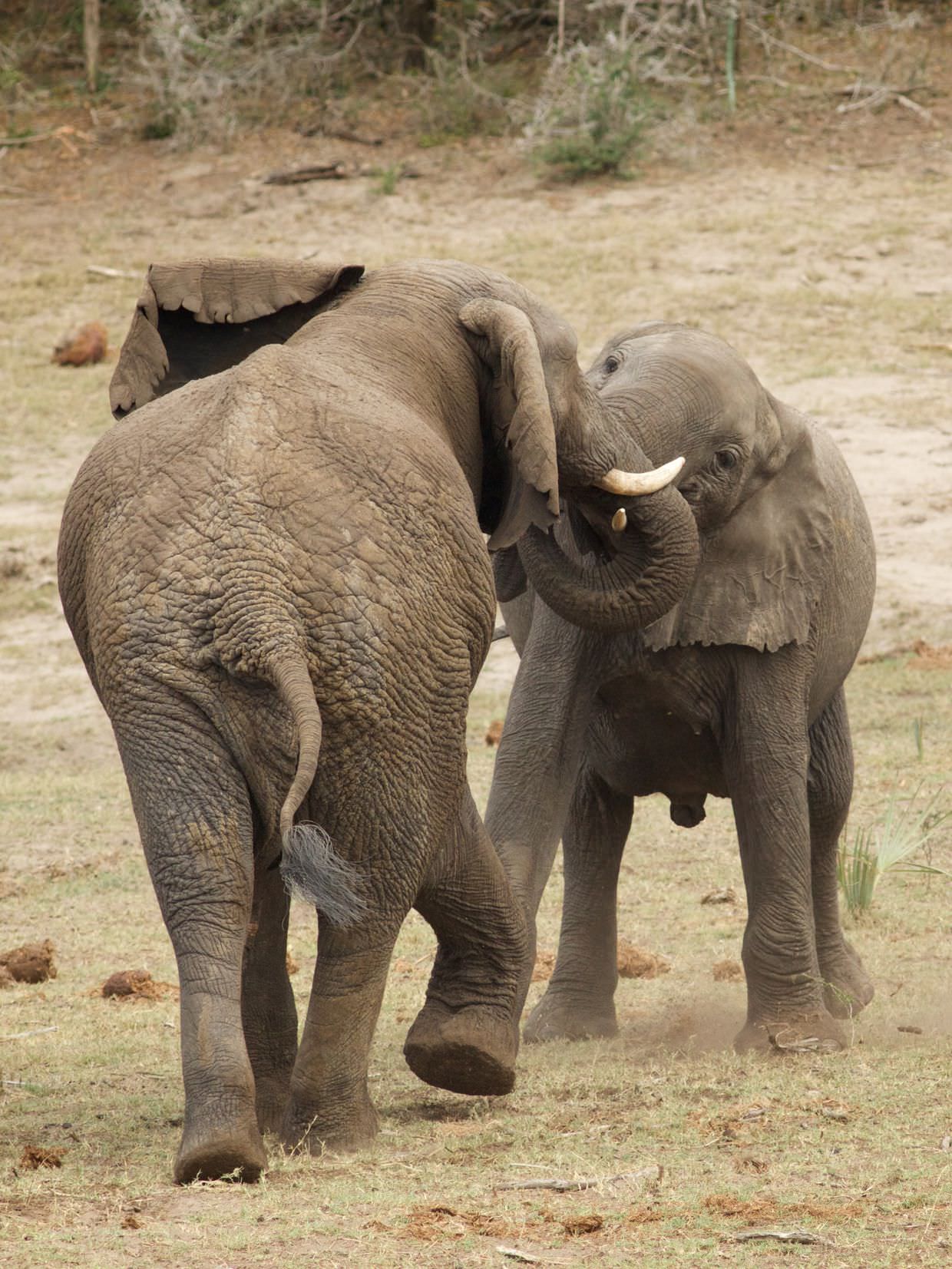
In the tree tops and around the waterhole we watch collared sunbirds, marico sunbirds, african yellow white-eyes and cinnamon-breasted buntings. At the back a pair of southern black flycatchers swoop in and out of the tree, down to the water’s edge, picking up bugs. Above us, in the thatched rafters, our own bug – a large orb weaver spider emerged, black with yellow marks.
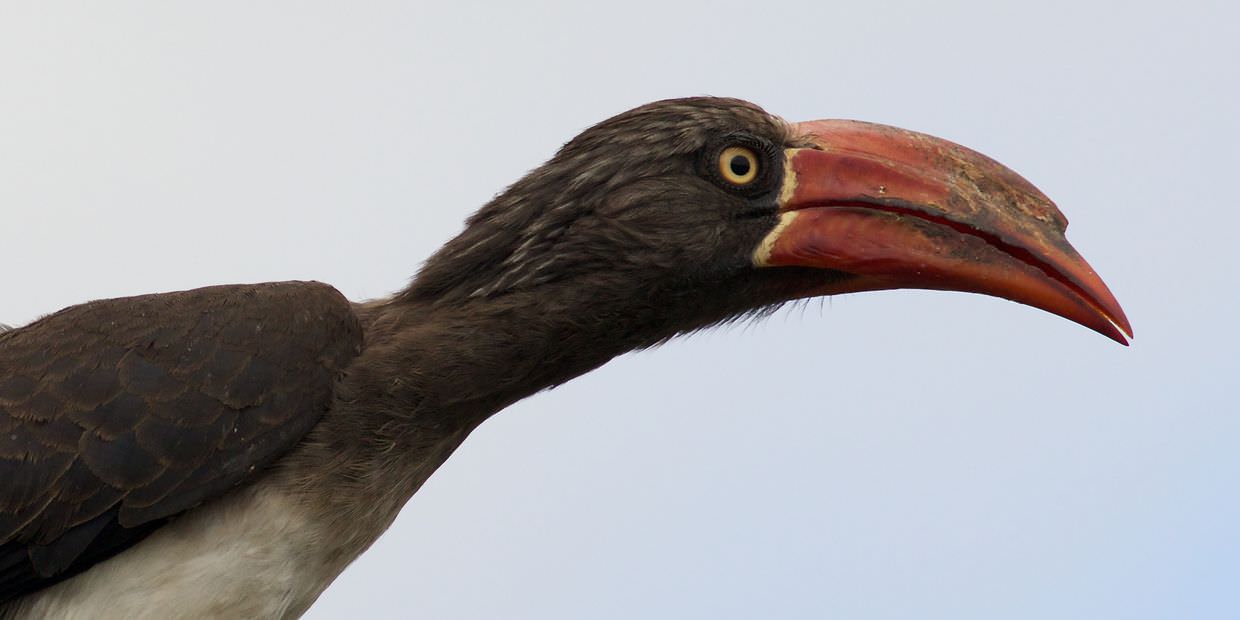
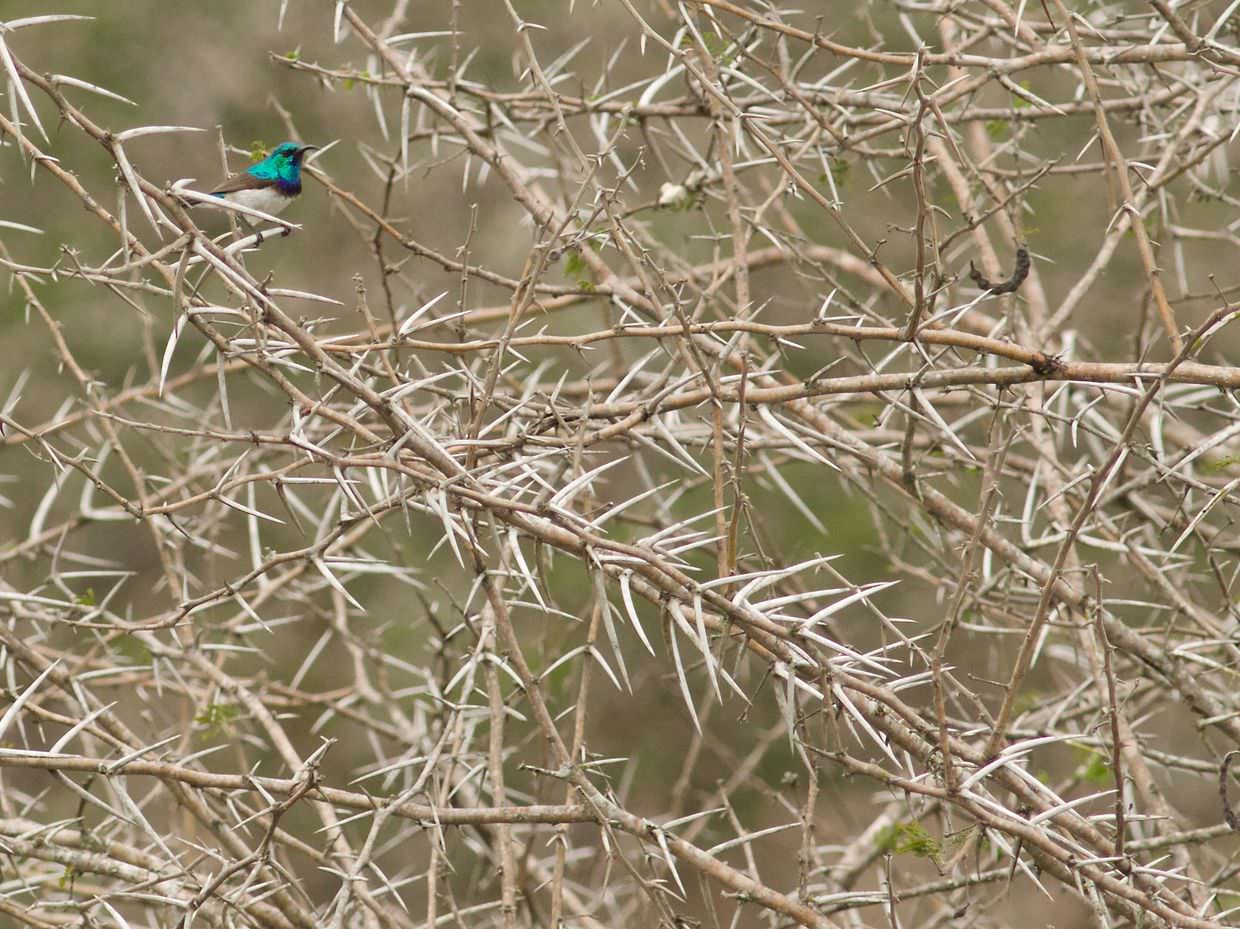
No signs of Elsa
In the afternoon we wanted to try again with Elsa, we had our bait ready, but there’s no sign of her and we don’t pick up a signal. Hunting elsewhere perhaps? We hang around, watching the pack feed on the remains of a nyala, a pied crow braves it too.
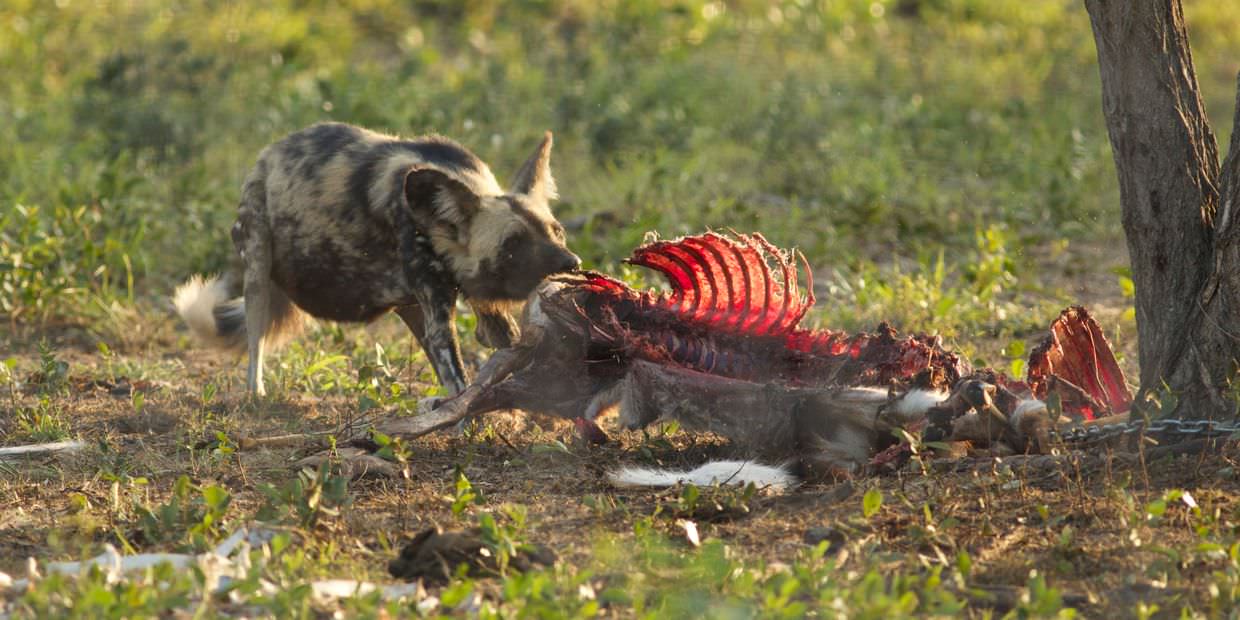

It was a beautiful sunny evening, and now the sun was setting we headed out into the fields, scanning for lions. In this relatively flat area, “relatively”, most of Tembe is flat, it’s hard to get signal without getting up high. Getting up high means climbing trees; Hayden loves any excuse to climb a tree, and with the telemetry he skittled up the branches to the top, before any of us volunteers could decide whether to go with him or not. We couldn’t find the lions, but the sunset was superb.
